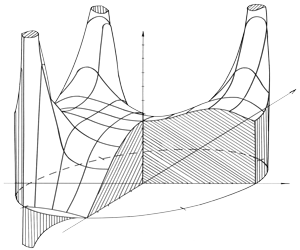Controlled electric field in multiply connected circular structure
DOI:
https://doi.org/10.3103/S0735272712060052Keywords:
electric field, electric field intensity, electric field potential, homogeneity area, controlled field, discrete field rotation, uniform rotation of fieldAbstract
This paper presents the analysis and calculation of homogeneity zone of controlled (rotating) electric field in the internal area with circular multiply connected border and equal lengths of boundary arcs depending on the order of border connectivity, potential distribution across the boundary arcs, and the ratio between the lengths of boundary arcs and gaps between the arcs. Mathematical expressions are presented both in the form of complex variable functions and as sums of spatial harmonics.
References
- Yu. F. Zin’kovskii, Yu. K. Sidoruk and A. V. Goloshchapov, “The Problem of Conjugation in Calculations of Electric Field Strength and Potential of a Ring-Shaped Multiply Connected Structure,” Izv. Vyssh. Uchebn. Zaved., Radioelektron. 50(5), 76 (2007) [Radioelectron. Commun. Syst. 50(5), 284 (2007)].
- Yu. F. Zin’kovskii, Yu. K. Sidoruk, and A. V. Goloshchapov, “Electric Field Density in the Region with Circular Multiply Connected Border and Equal Lengths of Bounding,” Izv. Vyssh. Uchebn. Zaved., Radioelektron. 52(2), 14 (2009) [Radioelectron. Commun. Syst. 52(2), 63 (2009)].
- Yu. F. Zin’kovskii, Yu. K. Sidoruk, and A. V. Goloshchapov, “Representation of Electric Field Strength and Potential in the Region with Circular n-Connection Boundary as a Sum of Space Harmonics,” Izv. Vyssh. Uchebn. Zaved., Radioelektron. 52(7), 11 (2009) [Radioelectron. Commun. Syst. 52(7), 340 (2009)].
- I. S. Gradshtein and I. M. Ryzhik, Tables of Integrals, Sums, Series, and Products (Nauka, Moscow, 1971) [in Russian].
- M. A. Lavrent’ev and B. V. Shabat, Methods of the Theory of Complex Variable Functions (Lan’, St. Petersburg, 2002) [in Russian].
- N. I. Muskhelishvili, Singular Integral Equations: Boundary Problems of the Theory of Functions and Certain Applications to the Mathematical Physics (Nauka, Moscow, 1968) [in Russian].

Downloads
Published
2012-06-01
Issue
Section
Research Articles

